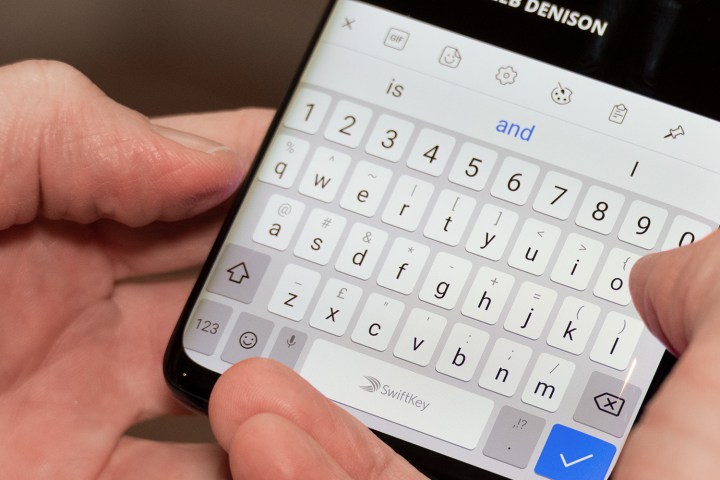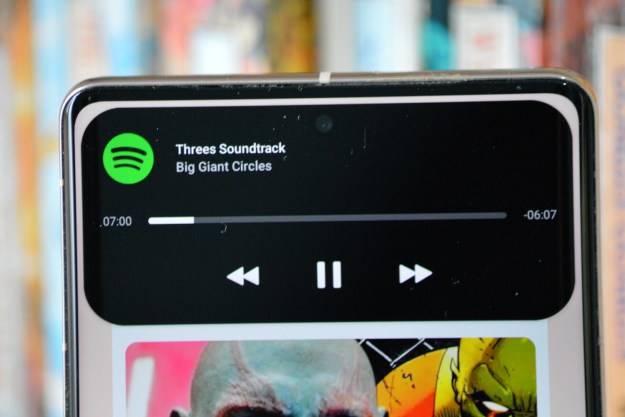
Smartphones with screen-to-body ratios in the high 80-percent and beyond look great — they’re futuristic, sleek, and minimalist — but there’s a problem with the bezel-less design trend that has nothing to do with notches, and everything to do with chins. It’s something that’s only going to get worse in 2019, as not only will truly bezel-free phones become more common, but folding smartphones will start to emerge too.
What are we talking about? It’s typing comfort. A crucial part of the smartphone experience that’s being ruined by thoughtless software design. The chin is the bottom bezel or edge of the screen. As companies slim down the edges more an more in favor of more screen real estate, the chin has become an endangered species. Typing on a touchscreen has become more of a challenge, and something needs to be done about it before we all end up with crooked, arthritis-riddled thumbs.
Chin up
What happened? Think back to when you used a phone with a chin, or one that had a front fingerprint sensor. Take for example, the Samsung Galaxy S7, the Xiaomi Mi A2, the LG G6, the HTC U12 Plus, or any iPhone up to the iPhone 8. The chin, or lower screen bezel, was the place where your thumb pad naturally rested when holding the device.
The cumulative effect of these trends has seen the keyboard drop much closer to the bottom of the phone’s screen.
When typing, the keyboard appeared on screen and was automatically up to an inch above the bottom of the phone. It was comfortable and natural, and your thumbs sat at a 45-degree angle when typing. Strain was rare, each key was easily reachable, and the danger of dropping the phone when typing with two hands was slim. Today, the chin has been mostly eradicated and gesture control systems are common. The cumulative effect of these trends has seen the keyboard drop much closer to the bottom of the phone’s screen.
This is where the problems start. As an example, let’s look at two manufacturers that make great-looking, almost bezel-less smartphones, but also two most egregious typing-comfort sinners today — Huawei and Honor. On the Mate 20 Pro and the Honor View 20 with the gesture controls active, the keyboard sits almost flush with the bottom of the phone, forcing your hands to adopt a clawed position as you attempt to type. The faster you tap out words, the worse the accuracy gets, and it’s because your thumbs are stuck in an unnatural position, unable to easily reach the bottom row of keys. Spend a long time typing, and cramp sets in. Not good at all.

There are ways to make typing more comfortable on this type of phone. Resting the bottom of the device against two fingers rather than just your pinky acts as a basic replacement chin, or you can use Google’s Gboard keyboard and switch to the floating keyboard option. Neither are ideal, and because gesture controls have improved a lot, it’s less appealing to return to the old Android system with keys at the bottom of the screen.
But we shouldn’t have to do any of these things. Software designers should be addressing the problem, and ensuring one of the things we do the most on our phones isn’t painful or frustrating.
Who gets it right?
Huawei and Honor haven’t yet solved the problem of how to artificially raise the keyboard without ruining the look of the software and screen. The same issue arises on the OnePlus 6T, and chinless wonders like the Oppo Find X also suffer. Ultimately, we have to change our grip to type without getting cramp. This is a serious worry, as phones like the Find X are slim, light, and slippery. We’ve no wish to suddenly juggle with a $1,000 smartphone just because we’re fidgeting about while replying to a few messages.
Ultimately, we have to change our grip to type without getting cramp.
Neither Samsung nor LG have fully adopted a gesture-based control system, and therefore still use the traditional Android navigation keys at the bottom of its screen, making typing a little easier. But only for now. Phones like the Google Pixel 3 haven’t abandoned the chin at all, to the detriment of the design, but at least typing remains a pleasing, cramp-less experience. It’s only Apple that has managed to get the balance exactly right, with the voice control and and language option buttons acting as an artificial chin under the keyboard in iOS 12.

Slowly but surely keyboards everywhere are edging closer to the bottom of the phone, and it’s not making it much fun to type quickly. However, what is a minor annoyance today is about to become more serious, due to the wider adoption of both bezel-less screens and gesture control systems, plus the launch of folding smartphones.
Folding smartphones will make it worse
Take a glance at the various folding smartphone prototypes and look at the lack of bezel. The Royale Flexpai, Samsung’s folding Galaxy phone, and the Xiaomi double-folder show screens from top to bottom, and side-to-side. No chin, and nowhere to hold the phone if the keyboard sits right at the base. Things will be even worse with the screen spread open for all to see. Have you ever typed quickly and easily on a tablet while holding it in landscape orientation? No, probably not, unless your digits resemble E.T.’s. Thicker devices may help grip, but may also reduce the amount of thumb-stretch we have to reach across the screen.
Have you ever typed quickly and easily on a tablet while holding it in landscape orientation? No, probably not.
The thing is, we really don’t know how it will be. We can only be concerned because we can see how things are going now. We do know the software design is a serious challenge for foldable smartphones. Google is already heavily involved in trying to get it right, and Xiaomi has spoken out about its work on the time invested in getting MIUI (its version of Android installed on its phones) to work on its prototype.
Next-generation keyboards for next-generation phones
It’s annoying now, but we can see this ambivalence towards the typing experience gradually creep in everywhere, as the race to rip out the chin and add gesture navigation accelerates. We’d rather poor keyboard placement didn’t become common place on the next generation of smart devices, so what can be done, outside of buying a BlackBerry?
Now is the time to remind manufacturers of how important it is to get the typing experience exactly right.
Software engineers and designers are already hard at work making next-gen operating systems to suit next-generation hardware, and we want them to pay serious attention to the keyboard, where it’s placed, and how comfortable it is to use on a daily basis. Repetitive strain injury shouldn’t be a downside of mobile ownership, and we’re not keen on being permanently disfigured due to crippling arthritis just because we need to type on a virtual keyboard everyday.
Yes, new bezel-less phones look great and we can’t wait to try more foldable smartphones, but the old way of displaying and using a keyboard is still the best. Human thumbs simply don’t want to, and shouldn’t have to bend to the will of poorly designed software.
Editors' Recommendations
- Apple just released iOS 17.4. Here’s how it’s going to change your iPhone
- It’s finally happening — your iPhone is getting RCS in 2024
- Samsung just killed one of its most important Android phones
- Your next iPhone may have no bezels. Here’s why that could be a problem
- I tried to replace my GoPro with this new phone and its clever camera



